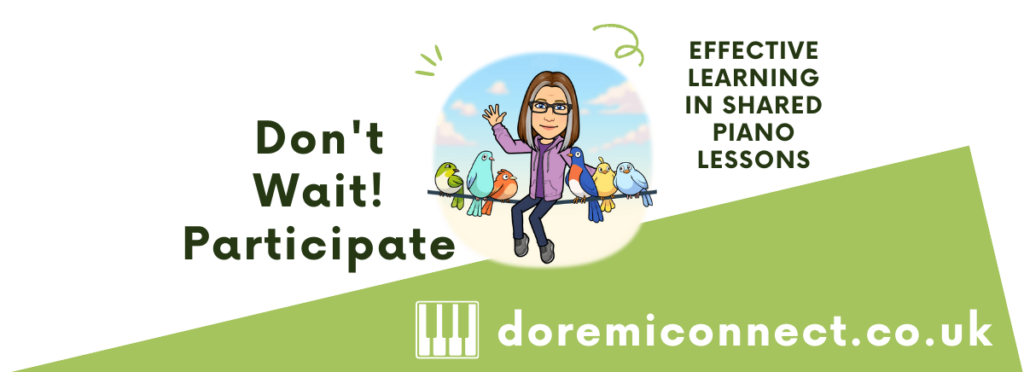Don’t Wait! Participate! – Effective Learning in Shared Piano Lessons

One of the wonderful things about music is that it connects people. However learning piano can be a solitary endeavour with fewer opportunities for ensemble work than other instruments. Maybe shared piano lessons are the key?
In Doremi Piano lessons, the majority of a beginner’s lessons are spent away from the keyboard. We use singing and games to teach the fundamentals of music, and the specifics of the pieces. Then when we sit at the piano, it’s only the technical demands of the instrument that we need to tackle.
This is a great advantage when beginner students are sharing a lesson because a song or a game away from the piano can be done by 1, 2, 3 or more students at the same time, with the same high quality outcomes. In fact many of the games are improved with a few more bodies in the room. So shared piano lessons can be really beneficial.
Why not try these game ideas?
Taken from the Doremi Teach Piano curriculum for Doremi Members
#1 Patacake style games where the actions match a musical element from the song eg rhythm, metre or melodic contour
#2 Guessing games where students are identifying a selected rhythm or melody
#3 Acting games where the activity relates to the meaning of the lyrics
#4 Dancing games are particularly good for preparing musical form and phrasing
Why do we play games?
Practice makes progress. Repetition is vital and the students will love repeating these games. You will get bored before they do! In addition, a less confident student can be subtly helped by their proximity to a more confident student in an anxiety free, playful situation.
Even when it comes to sitting at the piano, many of the activities you’ve just completed can be done by the waiting student. No longer do they have to wait passively.
Don’t wait – participate!
The following activities can be completed by “waiting” students while the performer plays
#1 Clapping games
#2 Creating an ostinato from body rhythms
#3 Saying rhythm names or silently showing rhythm actions
#4 Singing solfa or silently hand signing
#5 Conducting or showing the metre or beat
#6 Listening for areas to improve and providing specific feedback
In fact, these cooperative activities are so beneficial to both students, that I take the part of the partner in solo lessons too.
However my absolute favourite thing is when my piano students join in my weekly singing and Kodály musicianship classes. Then we can really make some music together, and their piano progress gets a real boost!
Doremi Members get access to my full curriculum for piano lessons, singing and musicianship group classes AND my Progress Diary for setting up a brand new class. Why not check it out today?
Want More?
Grab my Free Kodály Treasure Chest, which includes more teaching ideas, including my mini course on the The Benefits of Singing Games.
Responses